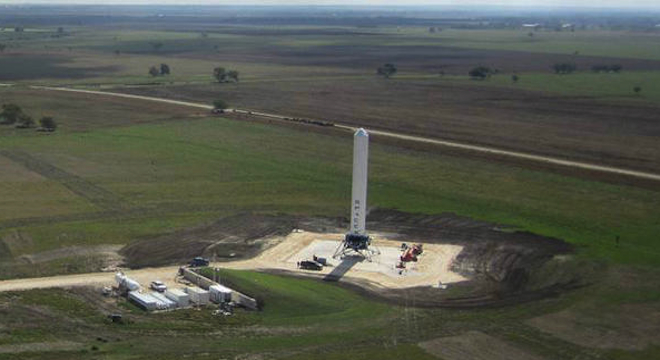SpaceX has over the past few months been testing a new experimental reusable rocket design, which the company calls “Grasshopper,” launching and landing it twice in two separate “test hops,” from its site in McGregor, Texas.
The Hawthorne, California-based company’s ultimate goal, and that of its founder Elon Musk, is to drastically reduce the current costs of space travel to get them closer to airfare costs — down from $1,000 per pound to $10.
Or, as SpaceX put it in a statement to TPM: “SpaceX believes that developing vehicles that are fully and rapidly reusable is a key element to radically reducing cost and increasing the efficiency of spaceflight. Grasshopper is a vertical takeoff and landing test vehicle (VTVL) that provides a critical step toward reusability.”
Already, SpaceX has made world history this year by performing the first-ever “berthing” — or unpowered docking — of a privately-owned and operated spacecraft with the International Space Station. SpaceX in October also successfully accomplished the first-ever official cargo resupply mission by a commercial spacecraft to the space station. SpaceX has a $1.6 billion contract with NASA for 11 more resupply flights.
SpaceX’s custom built Dragon capsule and Falcon 9 rocket were used for both of those missions, but in those instances, the Falcon 9 rocket’s first stage separated from the Dragon before it reached orbit and plummeted to the ocean as intended. SpaceX would like to be able to reuse this stage, but hasn’t been able to yet.
Another Falcon 9 rocket and one of its Merlin engines form the basis of the company’s new Grasshopper test vehicle.
But the components have been reconfigured into a gigantic new craft that towers 10 stories tall and contains four standing steel legs, which allow the craft to land precisely vertically — vertical takeoff, vertical landing (VTVL).
SpaceX on Friday published to its Google Plus page the following low-angle photo of the Grasshopper sitting on the test launch site in McGregor:

As SpaceX wrote in the post: “If you watched Grasshopper’s recent two-story hop (see link below), this photo shows the scale of the 10-story rocket. Note the people and bus.”
Earlier in the week, Musk himself tweeted another shot, this one an aerial view of the Grasshopper, writing: “Note SUV and person nearby for sense of size.”

SpaceX also performed two “test hops” of the Grasshopper in September and early November and posted videos of the events online. A SpaceX spokesperson told TPM that the control software used for the second test hop, which lasted 8 seconds, was a new version.
The company intends to continue test launching, or performing test hops with the Grasshopper at consecutively higher levels over the next three years, until it is capable of reaching suborbital space. Musk in February told Popular Mechanics that he hoped to achieve “supersonic” VTVL test flights by the fourth quarter of 2012. Time is certainly getting close for that.






